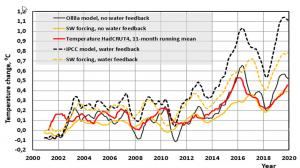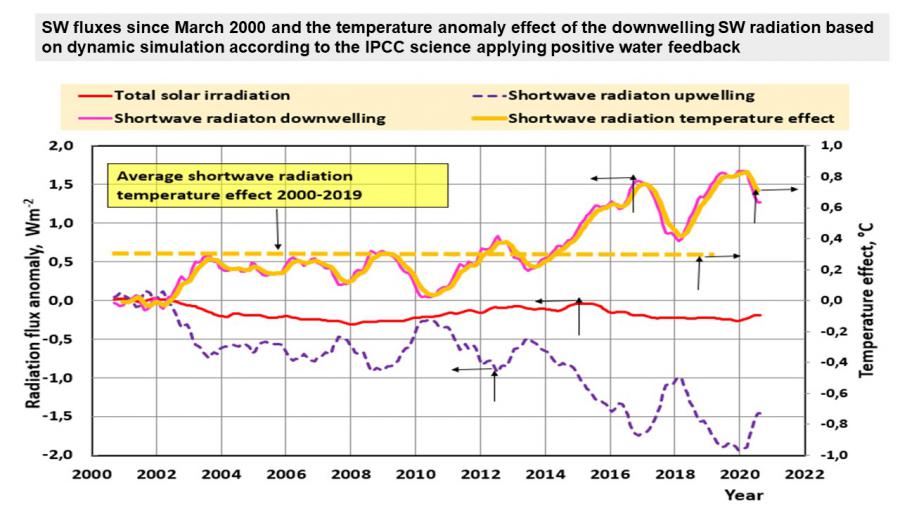[ad_1]
The strong positive shortwave radiation anomaly since 2001

The results of the temperature simulations of the IPCC and Ollila models

Earth’s energy balance showing the magnitude of the greenhouse effect
The IPCC climate models ignore the sharp increase in solar radiation since 2001. The IPCC tries to cover up the violation of the physical laws of its definition of the GH effect
PORVOO, UUSIMAA, FINLAND, Aug 16, 2021 /EINPresswire.com/ – According to the latest IPCC 6 (AR6) assessment report, the observed temperature increase and the temperature increase calculated according to climate models have been almost the same 1.3 ° C from 1750 to 2020. The report shows a strong positive trend in shortwave solar radiation from 9/2000 to 6/2017, but its impact was omitted in the post-2000 warming calculations, this which may explain the high temperatures since El Niño of 2015-2016. For example, the temperature effect in 2019 is around 0.7 ° C according to AR6 science. In fact, the IPCC models give a 2019 temperature increase of 2.0 ° C (1.3 ° C + 0.7 ° C). This 54% error is due to the positive feedback of water applied in climate models, which doubles the impact of other climate forcings such as greenhouse gases and which, according to this natural experiment by climate, does not ‘does not exist.
The amount of carbon dioxide in the atmosphere has increased by 32% since 1750. According to AR6, this is only due to anthropogenic anthropogenic emissions that remain there (remained, accumulated) averaging 44% per year and the rest was absorbed by the oceans and vegetation. About 25% of atmospheric carbon dioxide changes each year from oceans and vegetation. As a result, less than 6% of the initial amount of carbon dioxide in the atmosphere remains after 10 years, and therefore the increased amount of carbon dioxide in the atmosphere cannot be entirely anthropogenic with a value for thousand of -28 ‰. The IPCC is silent on permille values, because in AR6 there is no word “permille”, which is a measure of the ratio of carbon isotopes and it was used to analyze the origin of carbon dioxide. carbon, suitable for validating carbon cycle models.
The cover-up of this problem continues with the anthropogenic lifespan of carbon dioxide in the atmosphere, which is now roughly hundreds of years to thousands of years. The rate of removal of radioactive carbon from the atmosphere (a perfect tracer test for anthropogenic carbon dioxide) after 1964 is only 64 years. The recovery time of the total atmospheric amount of carbon dioxide at the 1750 level can be estimated to be similar to that of its accumulation period, that is, just under 300 years.
The AR6 report no longer uses the IPCC’s own definition of the greenhouse effect, except in the glossary. The definition no longer contains the description of how the greenhouse gas absorption of 158 W / m2, which causes the greenhouse effect according to the IPCC, creates infrared radiation down to the ground of 342 W / m2 . It is against fundamental physical laws because energy comes from nothing. Radiation to the surface consists of four energy flows which, according to the IPCC energy balance, are greenhouse gas absorption of 158 W / m2, the latent heat of water 82 W / m2, the sensible heat (hot air) 21 W / m2 and solar radiation absorption in the atmosphere 80 W / m2. The three energy flows mentioned first, which total 261 W / m2, maintain the greenhouse effect.
By distorting the magnitude of the greenhouse effect to the absorption of greenhouse gases alone, the IPCC is able to increase the contribution of carbon dioxide to the greenhouse effect by about 7.5% to 19%, and the temperature effect of 2.5 ° C to 6.3 ° C. It also means that the equations used by the IPCC to calculate the radiation forcing values ​​and the global warming impacts of carbon dioxide for increasing carbon dioxide concentrations are not in agreement with the contribution of carbon dioxide. carbon in the greenhouse effect.
IPCC science as the basis for climate change in the Paris Agreement gives carbon dioxide a greatly exaggerated warming capacity. In 2019, the 2-degree limit was already exceeded according to IPCC climate models.
Antero Ollila
Aalto University (Em.)
[email protected]
![]()
[ad_2]




